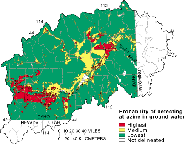
The highest frequencies of detection for pesticides in ground water were for herbicides in shallow ground water beneath agricultural areas. In these areas where herbicide use was moderate to high, soil and geologic conditions favored rapid movement of herbicides to the ground water. Most studies of shallow ground water in agricultural areas detected herbicides in more than 50 percent of wells sampled.
Compared to streams, ground-water detections were dominated by fewer compounds--mainly those that have the combination of relatively high mobility and chemical stability that allows them to move and persist in the flow system long enough to reach a well. Only atrazine, its breakdown product DEA, metolachlor, prometon, and simazine were found in more than 5 percent of all wells.
Of the 36 studies of shallow ground water in agricultural areas, which included more than 1,000 wells, only one well in an unused shallow ground-water area in the Connecticut, Housatonic, and Thames River Basins had an atrazine concentration that exceeded the drinking-water standard of 3 µg/L.
Herbicides were moderately common in shallow ground water beneath urban areas. In an urban area of the Albemarle-Pamlico Drainage, a shallow aquifer used for drinking-water supply had one monitoring well where an atrazine concentration exceeded the drinking-water standard.
Major aquifers, all of which are drinking-water sources, are generally deeper than the shallow ground water studied and had distinctly lower detection frequencies of herbicides. Only 3 of 33 aquifers sampled had among the highest ranked detection frequencies, and none of the wells sampled in major aquifers had herbicide concentrations that exceeded drinking-water standards or guidelines.
Ground-water contamination, compared to stream contamination, is more strongly governed by soil and geologic conditions, and each well is uniquely affected by sources of pesticides and flow conditions in its immediate vicinity. Local variability in these conditions can result in degradation of water quality in one or a few wells, even if most wells are not affected. The greatest frequencies of herbicide detection in major aquifers occurred in vulnerable settings. The three aquifers with the highest frequencies of detection were (1) the Platte River Alluvial aquifer in the Central Nebraska Basins, which is shallow and overlain by permeable sandy soils, (2) the Upper Floridan aquifer in the Appalachicola-Chattahoochee-Flint River Basin, which is a limestone formation where flow rates are high, and (3) a shallow limestone aquifer in the Lower Susquehanna River Basin.
|
PREDICTING ATRAZINE CONTAMINATION IN GROUND WATER As part of Idaho's State Pesticide Management plans for herbicides, maps have been developed to portray the potential for atrazine contamination in ground water in southeastern Idaho.(42) Atrazine data from the NAWQA Program in the Upper Snake River Basin were used to calibrate and verify predictive models. Significant factors used to successfully predict atrazine concentrations in ground water were atrazine use, land use, precipitation, soil type, and depth to ground water. Continued development of these types of modeling tools will aid in designing cost-effective programs for monitoring and protecting ground-water resources across the Nation. |